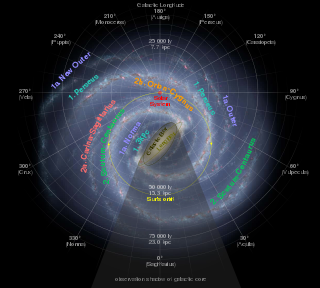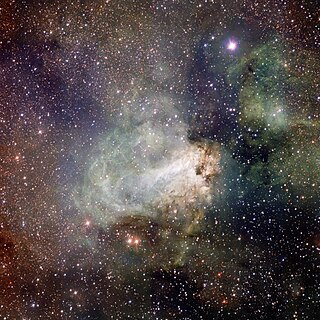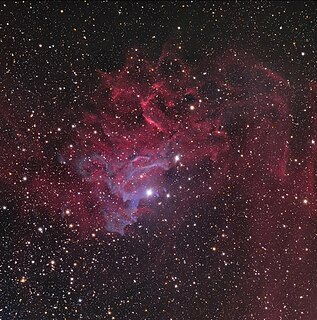
A nebula is an interstellar cloud of dust, hydrogen, helium and other ionized gases. Originally, the term was used to describe any diffused astronomical object, including galaxies beyond the Milky Way. The Andromeda Galaxy, for instance, was once referred to as the Andromeda Nebula before the true nature of galaxies was confirmed in the early 20th century by Vesto Slipher, Edwin Hubble and others.

The Orion Nebula is a diffuse nebula situated in the Milky Way, being south of Orion's Belt in the constellation of Orion. It is one of the brightest nebulae, and is visible to the naked eye in the night sky. It is 1,344 ± 20 light-years (412.1 ± 6.1 pc) away and is the closest region of massive star formation to Earth. The M42 nebula is estimated to be 24 light years across. It has a mass of about 2,000 times that of the Sun. Older texts frequently refer to the Orion Nebula as the Great Nebula in Orion or the Great Orion Nebula.

The Rosette Nebula is an H II region located near one end of a giant molecular cloud in the Monoceros region of the Milky Way Galaxy. The open cluster NGC 2244 is closely associated with the nebulosity, the stars of the cluster having been formed from the nebula's matter.

NGC 604 is an H II region inside the Triangulum Galaxy. It was discovered by William Herschel on September 11, 1784. It is among the largest H II regions in the Local Group of galaxies; at the galaxy's estimated distance of 2.7 million light-years, its longest diameter is roughly 1,520 light years (~460 parsecs) (14.38031 exameters), over 40 times the size of the visible portion of the Orion Nebula. It is over 6,300 times more luminous than the Orion Nebula, and if it were at the same distance it would outshine Venus. Its gas is ionized by a cluster of massive stars at its center with 200 stars of spectral type O and WR, a mass of 105 solar masses, and an age of 3.5 million years; however, unlike the Large Magellanic Cloud's Tarantula Nebula central cluster (R136), NGC 604's one is much less compact and more similar to a large stellar association.

The Eagle Nebula is a young open cluster of stars in the constellation Serpens, discovered by Jean-Philippe de Cheseaux in 1745–46. Both the "Eagle" and the "Star Queen" refer to visual impressions of the dark silhouette near the center of the nebula, an area made famous as the "Pillars of Creation" imaged by the Hubble Space Telescope. The nebula contains several active star-forming gas and dust regions, including the aforementioned Pillars of Creation. The Eagle Nebula lies in the Sagittarius Arm of the Milky Way.

The Orion Arm is a minor spiral arm of the Milky Way Galaxy that is 3,500 light-years across and approximately 10,000 light-years in length, containing the Solar System, including Earth. It is also referred to by its full name, the Orion–Cygnus Arm, as well as Local Arm, Orion Bridge, and formerly, the Local Spur and Orion Spur.

Messier 10 or M10 is a globular cluster of stars in the equatorial constellation of Ophiuchus. The object was discovered by the French astronomer Charles Messier on May 29, 1764, who cataloged it as number 10 in his catalogue and described it as a "nebula without stars". In 1774, German astronomer Johann Elert Bode likewise called it a "nebulous patch without stars; very pale". Using larger instrumentation, German-born astronomer William Herschel was able to resolve the cluster into its individual members. He described it as a "beautiful cluster of extremely compressed stars". William Parsons, 3rd Earl of Rosse thought he could distinguish a dark lane through part of the cluster. The first to estimate the distance to the cluster was Harlow Shapley, although his derivation of 33,000 light years was much further than the modern value.

The Omega Nebula, also known as the Swan Nebula, Checkmark Nebula, and the Horseshoe Nebula is an H II region in the constellation Sagittarius. It was discovered by Philippe Loys de Chéseaux in 1745. Charles Messier catalogued it in 1764. It is by some of the richest starfields of the Milky Way, figuring in the northern two-thirds of Sagittarius.

The Small Sagittarius Star Cloud is a star cloud in the constellation of Sagittarius, approximately 600 light years wide, which was discovered by Charles Messier in 1764. It should not be confused with the nearby Large Sagittarius Star Cloud which lies about 10° to the south.

Messier 25, also known as IC 4725, is an open cluster of stars in the southern constellation of Sagittarius. The first recorded observation of this cluster was made by Philippe Loys de Chéseaux in 1745 and it was included in Charles Messier's list of nebulous objects in 1764. The cluster is located near some obscuring features, with a dark lane passing near the center.

Messier 28 or M28, also known as NGC 6626, is a globular cluster of stars in the center-west of Sagittarius. It was discovered by French astronomer Charles Messier in 1764. He briefly described it as a "nebula containing no star... round, seen with difficulty in 31⁄2-foot telescope; Diam 2′."

The Beehive Cluster, is an open cluster in the constellation Cancer. One of the nearest open clusters to Earth, it contains a larger population of stars than other nearby bright open clusters. Under dark skies, the Beehive Cluster looks like a small nebulous object to the naked eye, and has been known since ancient times. Classical astronomer Ptolemy described it as a "nebulous mass in the breast of Cancer". It was among the first objects that Galileo studied with his telescope.

Messier 103 is an open cluster where a few hundred, mainly very faint, stars figure in Cassiopeia. It was discovered in 1781 by Charles Messier's friend and collaborator Pierre Méchain. It is one of the more distant open clusters, 8,000 to 9,500 light-years from the solar system and ranging over about 15 light years. It holds about 40 certain-member stars, two of which have magnitudes 10.5, and a 10.8 red giant, which is the brightest within the cluster. A bright known foreground object is the star Struve 131, not a member of the cluster. The cluster may have 172 stars if including those down to 50% probability of a gravitational tie. M103 is about 25 million years old.

The Caldwell catalogue is an astronomical catalogue of 109 star clusters, nebulae, and galaxies for observation by amateur astronomers. The list was compiled by Patrick Moore as a complement to the Messier catalogue.
The Herschel 400 catalogue is a subset of William Herschel's original Catalogue of Nebulae and Clusters of Stars, selected by Brenda F. Guzman (Branchett), Lydel Guzman, Paul Jones, James Morrison, Peggy Taylor and Sara Saey of the Ancient City Astronomy Club in St. Augustine, Florida, United States c. 1980. They decided to generate the list after reading a letter published in Sky & Telescope by James Mullaney of Pittsburgh, Pennsylvania, USA.

In astronomy, the Collinder catalogue is a catalogue of 471 open clusters by Swedish astronomer Per Collinder. It was published in 1931 as an appendix to Collinder's paper On structural properties of open galactic clusters and their spatial distribution. Catalogue objects are denoted by Collinder, e.g. "Collinder 399". Dated prefixes include as Col + catalogue number, or Cr + catalogue number, e.g. "Cr 399".

IC 5146 is a reflection/emission nebula and Caldwell object in the constellation Cygnus. The NGC description refers to IC 5146 as a cluster of 9.5 mag stars involved in a bright and dark nebula. The cluster is also known as Collinder 470. It shines at magnitude +10.0/+9.3/+7.2. Its celestial coordinates are RA 21h 53.5m, dec +47° 16′. It is located near the naked-eye star Pi Cygni, the open cluster NGC 7209 in Lacerta, and the bright open cluster M39. The cluster is about 4,000 ly away, and the central star that lights it formed about 100,000 years ago; the nebula is about 12 arcmins across, which is equivalent to a span of 15 light years.

IC 405 is an emission and reflection nebula in the constellation Auriga, surrounding the bluish star AE Aurigae. It shines at magnitude +6.0. Its celestial coordinates are RA 05h 16.2m dec +34° 28′. It surrounds the irregular variable star AE Aurigae and is located near the emission nebula IC 410, the open clusters M38 and M36, and the K-class star Iota Aurigae. The nebula measures approximately 37.0' x 19.0', and lies about 1,500 light-years away from Earth. It is believed that the proper motion of the central star can be traced back to the Orion's Belt area. The nebula is about 5 light-years across.

IC 2395 is an open cluster in the constellation Vela.


















